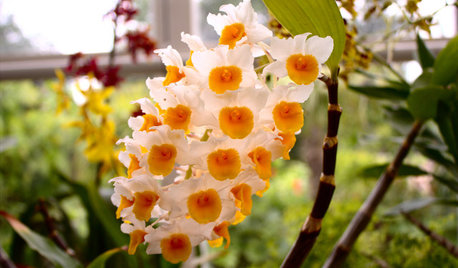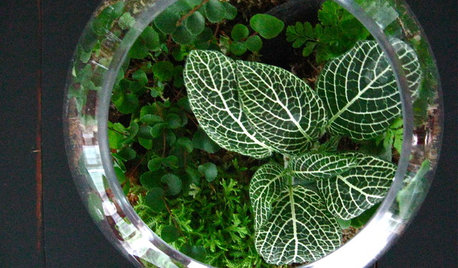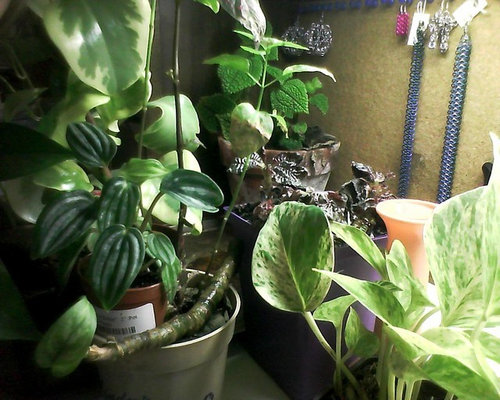I acquired quite a few plants over the summer and retain a small number from previous years. I have various questions about them and decided to put them all here and let you pick and choose which to answer, instead of making 20 different topics.
I'll try to put the more important ones near the top of the post. Try to remember that while I do have some knowledge of the subject, you probably will need to explain non-basic things instead of just referring to them.
General stuff: I'm in the Twin Cities, the first(my room's) window is on the south side with a couple small trees in front of it, the huge living room window is on the south side, and a north facing window which seems to get light levels in between that of the other two. These are the places where all these plants are. I gave most of these plants bigger pots when I got them because they almost always come thoroughly rootbound. I used what was available: a bag of potting soil. Seemed appropriate. The soil on our property is pretty sandy and not everything grows well in our garden. Come spring I should have some compost ready to use, though. I have had little luck with plant databases since everything from light needs to watering to temperature tolerance for a given plant is different on every site.
Is there a convenient way to monitor a plant's progress? I was unsure if a ring made around the stem made with a marker would damage it. Nowdays I go around the house and water everything at once around two times per week.
Pilea plants. I had one in the past and it died with no progress. I assumed that I had merely neglected to water it, so I decided to try again this year and got aluminum, involcrata, friendship, and 2 moon valleys. I find these plants quite interesting-looking. They're listed as low light, so I put most of them in my room. Unfortunately, despite my paying more attention to them, they're acting the same way. Slowly losing leaves one by one, never seeming to grow anything new(one seems to have stretched a bit vertically, but that's it. The few small leaves I see could have been there when I bought them). My house doesn't get a lot of light, but I've put them in different places and had varying watering habits(I view it as more of a chore now, while earlier I went by the website's instruction- every day). I haven't been able to see any activity at all and I'd be reluctant to give up on these cool plants, but it seems like the only choice unless something changes.
The philodendron/pothos style vine plants as a whole are actually doing quite well and all things considered, are my favorite class, but I do still have questions and a little trouble.
Two have grown quite noticeably.
The philodendron micans has gorgeous velvet leaves(although the new ones are very small) and the solid green pothos has reached an impressive 9-10 feet in the longer of the 3 pieces. The shortest end I placed in a small pot down on my desk without cutting it off, and now a few months later it's hanging a full foot or more out the other end. Does having a nutrient source near the end accelerate the growth? My main question for these two is a general one about propagation. I don't want to start chopping these things up, especially the accomplished pothos, without knowing what I'm doing first. I made that mistake with the micans, thinking it would work just like the Nephthytis, and now I have a few cut vines that aren't growing back. Yet a couple of them are growing, way back at the base in the pot instead of behind the cut. My secondary question is about the micans only- its unusual leaves look like they catch a lot of dust. Is this bad and if so, how do I clean them off?
An unidentified one that looks just like the pothos, but with very light colored leaves with small streaks of green and light brown. Possibly Marble Queen. It fits inside a pot just a few inches across, and hasn't budged this whole time. It's the only plant of this category that's definitely done squat. I decided to not repot it because although several big roots are showing, it's not matted like the others were. I'm going back on that decision, but I'd like to hear what you think first.
Philodendron silver: I don't really know what to make of this. Sometimes it looks like it has new growth and sometimes a leaf or two has turned yellow. Overall I know if there is any progress it's very slow and should be faster, looking at the others. The pattern is exquisite; I must get it growing.
I have another which looks like the silver but with regular colored leaves. Perhaps the "green" species, or grazielae. I can't tell if it's growing since it was already very long when I got it.
P.S. 1. One of the pothos vines is completely bare of leaves for a couple feet. Is a section like that still viable for propagation? 2. Is there a good way to find other varieties of this class of plant, or do I just need to repeatedly visit random Bachman's stores and hope for good luck? 3. I'm just wondering if instructions on care for and propagation of the other varieties will apply to the others too, since I'd like to eventually make up a pot that combines all my plants of this type.
Schefflera(maybe Luseane). I know this can work in my house because my parents have one already and it is our most magnificent plant. I got one myself, unsure of how it propagates and not wanting to sacrifice any of the main one, but after a while of decent growth, it just sort of rotted away. Like with the Pileas, I had been following the watering instructions on the Exotic Angel Plants website, which called for watering every 2 or 3 days, I believe. I also had it in my room, which has somewhat lower light.
My foxtail fern was just beautiful when I got it, but it didn't take long for its needles to turn hard and fall off, starting at the base. I desperately started watering it more since they seemed dry when they fell, but no dice. It did this nonstop for a month or more and nothing big changed with how we treated it, so I get it got bored of driving me insane. Now I have several slightly scraggly-looking stems whose bottom halves are bare, and it's finally sent up two new ones(though I had a new one early on, and it promptly died without producing any foliage, so I don't know if this is progress or not). What's going on? This is another I opted to not repot(even though I can feel tubers or something deforming the container), though I don't remember exactly why. Could be because the pot is already fairly big to find a place for, and I was afraid splitting it would result in ugly, lopsided plants. This was one of the most interesting ones, and I would love to know how to make it thrive.
My Asparagus Plumosus has such cool looking foliage, but its growth has been very erratic. As soon as I took it home it sent up a new vine that grew at an incredibly satisfying rate, maybe as much as an inch every day. But then it just stopped and sat there for months. It's happened one other time but stopped shorter. How do I get it to start growing again?
Following someone's advice, I have the pot lifted above a wide tray by rocks; excess water collects in there and it's supposed to help the plant with humidity. I can now see roots hanging down into the pool from the bottom of the pot.
The one I got most recently is a red and green polka dot plant. I do believe it's grown taller, but I have two complaints. First, it's not thick, tending to look nice right at the top and drop the rest of its limbs, leaving a long, empty stem. Second, some of its leaves lose color and crumble away, starting at the tips and getting closer and closer to the base. Salt in the water has been suggested as a culprit, but this doesn't happen to any other plants here and I don't know how I would resolve that.
3 hoyas: The two ropes aren't discolored or losing leaves, but they're completely stagnant. Absolutely nothing has happened with them since I got them months ago. I have them at different windows. How do I make them grow, and how do I propagate so it's not just one strand? The big lipstick plant is doing just fine at the north window- in fact, after it was neglected for a while and some parts of it died it not only recovered, but actually split in many places to be thicker than before. What I am wondering is if I can do anything to help the flowers. They only come a few at a time(sticking out like a sore thumb) and I've only seen a handful of them reach that second stage.
Fig vine(Ficus Pumila?)- 1. Will it grow a new tip if I cut one off and plant it? 2. Can I get it to climb, like on a cork board or something?
Unidentified plant which may be a type of Dracaena Marginata: As you will see in the picture, it's quite healthy, but it doesn't look as good as it could since it's just two long, bare stalks most of the way up. I'd like to know about propagation so I can multiply it and get more stems in there to thicken it up, and also what it's called.
Janet Craig Compacta - Has been stuck at about 0.7 feet tall for years. I've seen pictures of these higher up, with visible stems beneath the part I already have now, so either they were mislabeled or I'm doing something wrong.
The first picture shows the polka dot plant's dry & cracking leaves, the friendship pilea's sorry state, and three unidentified plants, none of which seem to be growing- the pothos-like one on the right, the thick cutting(was the source material too old? Do I need to get a soft piece?), and the tiny pot one, both of which have pilea-like patterns on the leaves. What are they and how do I get them to take off?
This post was edited by Mosinau on Tue, Dec 17, 13 at 4:51




















MosinauOriginal Author
kaktuskris
Related Professionals
Windham Landscape Architects & Landscape Designers · Arlington Landscape Contractors · Waterbury Landscape Contractors · Galt Landscape Contractors · Golden Gate Landscape Contractors · Muttontown Landscape Contractors · Norwalk Landscape Contractors · Palos Verdes Estates Landscape Contractors · Parkland Landscape Contractors · South Lake Tahoe Landscape Contractors · Irvington Landscape Contractors · Aspen Hill Interior Designers & Decorators · Lake Elsinore Interior Designers & Decorators · Little Egg Harbor Twp Interior Designers & Decorators · Channahon HandymanAmanda (asarumgreenpanda, z6MA)
MosinauOriginal Author
goren
Tiffany, purpleinopp Z8b Opp, AL
pirate_girl
emerald1951
pirate_girl
pirate_girl
MosinauOriginal Author
Tiffany, purpleinopp Z8b Opp, AL
pirate_girl
MosinauOriginal Author
pirate_girl
kaktuskris
MosinauOriginal Author
pirate_girl
MosinauOriginal Author